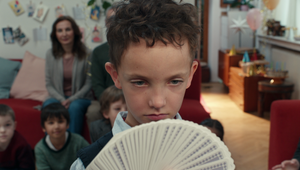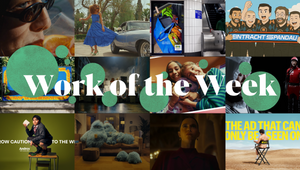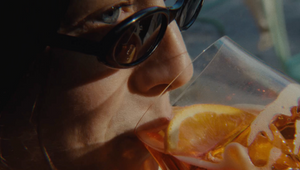
Behind Honda Moto’s Beautiful Fail

At the end of February this year, the Lyon Bicycle Show presented itself as the perfect opportunity for Honda Moto France to reveal 24 unique screen prints created by DDB Paris encompassing the story of 'The Beautiful Fail'. The silk screens brought the last edition of the 24H of Le Mans Moto back to life with one message that rang through them by Soichiro Honda - “When you fail, you also learn how not to fail.”
While as of last year, Honda had not really planned to communicate about the Le Mans race, due to an already full editorial calendar - according to Sébastien Pernel, marketing director at Honda Moto France - just a week before the Le Mans race, DDB Paris came forward with several ideas. For the agency, the initial brief was a classic win/loss print. “We quickly realised that if Honda won this year, they would become the most successful manufacturer in the 24 hours of Le Mans,” say Jean Weessa, art director and Damien Veillet, copywriter at DDB Paris. “The idea of documenting this race in real-time and print-screening it came up very quickly, we were so excited by this idea that it was the one we pitched strongly for.”
Not only were they going to document the epic story of the race, regardless of its outcome, but they would do it through draining the racing motor oil of the Honda CBR N5 and turning it into the ink used on the silk screens for the snapshots.
Surely enough, Honda were just as excited. Sébastien says: “One week later, we were with them in Le Mans 24h’s paddocks.”. At the race however, Honda came third, which set the unique story-telling pivot operation in motion. The silk screens were accompanied by taglines that evoke the highlights of the legendary Le Man race and show the human side of the competition, mistakes and all. Still deeming it ‘The most legendary of all endurance races’ and reminding that Honda had won it 13 times before, the combination of the moments DDB picked showed the determination, passion and all those important turning points. The agency also ran a special operation on Honda Moto France’s social networks to give fans of the manufacturer the chance to win a copy of each of the silk screens.
LBB’s Zoe Antonov spoke to Sébastien Pernel, Jean Weessa and Damien Veillet about how the unique screen-printing technique was developed, what portraying the beauty behind failing took and the intricacies of shooting racing bikes while still creating intimate photographs.
LBB> How did you settle on this unique approach to the screenprinting and what were the first steps you took towards bringing the photos to life?
Jean and Damien> We wanted to make sure that the race was also told by the machine.
We quickly chose engine oil, for its resemblance to ink. We thought it was organic to have the bike, through the oil, taking part of the story. Once we had the raw material (the oil and the photos), the first step was to visually depict 24 hours of racing, with day and night sequences. We were very careful to recreate in a realistic and homogeneous way the different light atmosphere from day to night.
The second constraint that imposed itself on us was to have a balance between man and machine. We tried to show the bike on the racetrack to have photos that appeal to our audience of motorcycle fans and more intimate portraits that give a human dimension to the 24h of Le Mans. And of course, we also had to tell the story of the race that led to this beautiful fail.
LBB> Tell me more about the technical process of draining the oil of the Honda CBR N5 and making the ink - did that come with its own challenges and how did you overcome them?
Jean and Damien> Successfully screen printing with motor oil was quite complicated. It was racing oil, so it had a very high viscosity index and would slip under the screen-printing mesh. We quickly started to mix it with fixatives to make it more consistent and we started internal tests in the agency basement. The first tests were conclusive, but we were reaching our technical limits. So, we found screen printers, Shlag Lab, who agreed to put oil in his machines. This was followed by long weeks of testing, to find the right balance between oil and fixatives that changed for each screen print.
Sébastien> We are obviously used to recovering oil after a race, as it gives us very important details about the engine and the bike. Transforming this oil into ink was something we had obviously never thought of (who could have?). DDB Paris worked with their silk-screening print workshop. We’ve seen a lot of trials and on July 14 2022, they made it.
LBB> How did you make the silk screens - what is the process for that and did you work with just one artist, or was there a team behind it?
Jean and Damien> The differences between the layouts with the original photos and the print screens were huge, we lost a lot of details, so we decided to adjust the contrast, mesh and ink consistency for each image. When everything was set up, the same image was printed 10 times because the oil reacted differently with each screen print. We created between two and four meshes a day. It took us approximately 10 days to screen print the whole campaign. During this process, we were two in the workshop, the screen printer, and the art director. We took the opportunity to film the case study images during the screen-printing process.
LBB> How did you settle on these particular 24 moments of Honda history for the campaign and why did you choose them?
Sébastien> Quickly after the race, DDB sent us their photo propositions with the moments they understood were pivotal regarding the third place of our racing team (vs. the podium we all expected). We adjusted with them, making sure they used the precise information provided by our analysts: time lapses, technical details, etc. Those 24 prints perfectly reflect the emotions, the intimacy, the disappointments, the ‘out-of-the-time’ moments our team lived during Le Mans ; and we can live it too through this creative work.
LBB> The copy on the prints is brilliant and an exercise in pure efficiency. How did you come up with it and were there some iterations that came close to being put on the prints but ultimately fell behind?
Jean and Damien> We wanted to tell an epic story, delivered with a realistic and documentary feeling. So, we chose to adapt our writing style to blend advertising copy and race commentary. The challenge was to conquer the hearts of motorcycle fans, but to popularise certain aspects of the race to a public of newcomers. Moreover, there was a double challenge. Each screen print had to be read and understood on its own, but also had to follow the chronology to form a unique and coherent global story.
LBB> Was there a lot of archive digging involved in the choice of the shots you'd depict? How long was the research process, what did it entail and how did you settle on these particular 24 'fails' in Honda's history?
Jean and Damien> 'The Beautiful Fail' only tells the story of the 2022 edition of the 24 Hours of Le Mans. We went to Le Mans with two photographers, one specialised in shooting racing bikes and another was in charge of following the team, to have a more intimate vision of the race. In the end, we shot more than 4500 photos to build our story.
LBB> How did you decide on the number of the shots that you would make and why did you particularly choose these moments?
Jean and Damien> We chose to produce 24 screen prints to follow each hour of the 24 hours of Le Mans.
We established a shooting list based on iconic moments (for example the start where we see the pilots running to their bikes), and then added the key moments of the race.
We knew that we would only get what the photographers could shoot. They had to be at the right place, at the right time since nothing was staged.
LBB> Which of the prints proved the most impactful? Why do you think that is?
Jean and Damien> We have no specific way of quantifying the impact of each screen print, but each connected with the audience in a different way and had a very specific message. We tried to vary the messaging among the 24 screen prints, ranging from very specific technical details to more internal, psychological moments.
LBB> Was there something distinctively French about this approach to the project? Why did you think it would work particularly well among French audiences?
Jean and Damien> The fact that the 24h of Le Mans is a French race is a real pride for us. The fans of Honda France are passionate about the event and go there every year.
We wanted to make them relive this event with something they have never seen before, from the inside, with the doubts and the joys of the team.
LBB> How does the campaign reflect Honda's brand pillars?
Sébastien> As you know, our tagline is 'The Power of Dream.'. In all of our communication, we keep in mind that we are talking to bikers with dreams, people that are proud of their bikes and proud to belong to the community. Many fans knew us through motorcycle races, and they have starry eyes when coming to Le Mans 24h, Bol d’Or or Enduropale. This campaign is directly addressed to them, giving them insights on their dreams, and reminding everyone a precious lesson: failing is necessary. As said by our founder Soichiro Honda 'Failing is the only way not to fail.'. At Honda, we are not satisfied with the status quo and are always looking for innovations, even if we must go through failures. We are very proud of this campaign, which embodies our mindset perfectly.
LBB> It takes a big dollop of brand bravery to engage in something so grounded in reality. How involved was Honda in the creative process and why was it important for them to partake?
Jean and Damien> Honda France is a unique client. The brand trusts the agency, and every time we've had the opportunity to work with them, that trust has brought the work to a better place.
We pitched them the idea a week before the race. Any client would have refused for obvious security and organisational reasons, but they accepted.
They opened as many doors as possible once we were in Le Mans, even letting us into the team paddock. Once the race was over, we took the time we needed to build the story and showed them the result.
They only had one comment. Change the picture of the screen print 'LAP 307 - Judas enters the race'. Originally, the silkscreen showed a picture of the blown-out exhaust, but since the manufacturer of the exhaust was a sponsor of the team, they did not want to jeopardise the commercial agreement between the manufacturer and the team. We chose to create a black-on-black screen print, as if we were in mourning.
They gave us a free hand with everything else. We are very proud to have been able to work for such courageous people that respect the creative work and share the same passion for racing.















